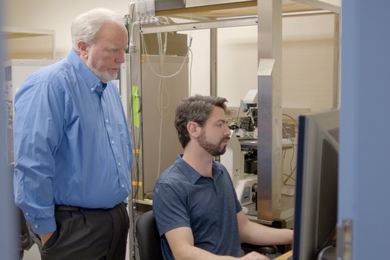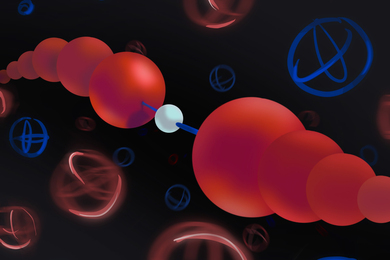In December 2009, 10 red weather balloons were deployed from locations throughout the United States. The project’s aim: testing the mettle of social media.
The Red Balloon Challenge, sponsored by the Defense Advanced Research Projects Agency (DARPA) of the U.S. Department of Defense, laid out a simple objective: Use social media to identify the GPS coordinates for all 10 balloons, suspended at fixed locations across the country. The first team to do so would win $40,000. The challenge, commemorating the 40th anniversary of the Internet, highlighted social networking’s potential to solve widely distributed, time-sensitive problems.
More than 4,000 teams entered the competition. Many concentrated their efforts on coverage, reaching out over the Internet to people over as large a geographic area as possible. Some teams tapped into large databases such as college alumni listservs, while others appealed to audiences on Twitter and Facebook.
The winning team, a group of MIT students, cast similarly wide nets across various social networks, but with a twist: The team devised incentives that motivated people to forward its message to others. The team promised $2,000 to the first person who submitted the correct coordinates for a single balloon, and $1,000 to the person who invited that person to the challenge. Another $500 would go to the person who invited the inviter, and so on.
The system quickly took root, spawning geographically broad, dense branches of connections. After eight hours and 52 minutes, the MIT team identified the correct coordinates for all 10 balloons, doling out some of the prize money to people in the 10 winning chains and donating the rest to charity.
In the process, the team collected an enormous amount of data on the size and scope of Internet connections. The researchers analyzed the data, and have published the results in the current issue of Science.
Finding the carrot that will stick
Alex “Sandy” Pentland, director of the Human Dynamics Laboratory in the MIT Media Lab, says finding the right incentive is essential to mobilizing large groups of people on a given task. With the right incentives, Pentland says people can work across social networks to accomplish goals beyond balloon searches.
“You can imagine scenarios like emergencies,” says Pentland, the Toshiba Professor of Media Arts and Sciences. “‘Where’s there a power generator?’ The word goes out, and it comes back in five minutes, and half a million people have thought about it for a microsecond. That would be amazing. Or there’s a lost child, and suddenly you have 10 million eyeballs looking. You can see things like that being enormously valuable.”
Using incentives to spread information over a social network is certainly not a new idea. Referral marketing programs commonly use incentives to attract, for example, new magazine subscribers, by giving coupons to friends who refer other friends.
Pentland and his team found their “recursive incentive mechanism” was far more effective than such marketing strategies. In such a system, a person doesn’t necessarily have to pass the message along to the person who subscribes to a magazine. She can gain by simply passing the message along to someone.
This video illustrates how referral between participants of the MIT team spread on the continental United States before and during the DARPA challenge.
Video: Wei Pan
The team compared its results with those of an online newsletter subscription campaign, and found the number and size of “cascades,” or branches of people recruiting others, was significantly larger for the balloon task. The researchers also observed their scheme produced a lower “attrition rate,” or points where people failed to forward the message.
Pentland’s group also found that their approach had the advantage of speed. The promise of a staggered reward spurred people to quickly reach out to others, versus newsletter subscribers, who exhibited a more delayed response.
A twist on tweets
The group also evaluated its performance against that of other top Red Balloon Challenge teams by analyzing data from Twitter. The students compiled more than 100 million tweets with the word “balloon” during the month before the balloon launch, analyzing them for the top five finalists.
Based on Twitter data, altruism wasn’t the ideal incentive: A team from the Georgia Institute of Technology’s Research Institute (GTRI), which placed second in the competition, generated a limited number of tweets through its altruism-based approach, which promised to donate prize money to the American Red Cross if people signed on to the challenge.
The data also suggested that existing Twitter audiences didn’t necessarily help spread the word. Infamous iPhone and PlayStation 3 hacker George Hotz, who has more than 35,000 followers on Twitter, prompted an initial burst of tweets when he announced the challenge on his feed. Similarly, a team named Geocacher appealed to an existing community of geocachers — people who use navigational techniques to identify hidden objects. Both teams, despite their established audiences, failed to sustain a large presence on Twitter for the Red Balloon Challenge.
In contrast, the MIT team started without a Twitter community. But within a couple of days, it was able to generate a Twitter following comparable to Hotz’s. What’s more, the team observed that when media outlets reported MIT as the winner of the challenge, the number of tweets actually declined, suggesting that the team’s incentive structure played a large role in generating tweets.
Erica Briscoe, a research scientist and a member of the GTRI team, says MIT’s extrinsic reward structure — promising monetary reward — helped the team generate a large social network quickly.
“I think the challenge brought up the question, ‘What kind of incentives do you need to participate?’” Briscoe says. “And it does seem their incentive scheme was more motivation for people to form that network.”
The MIT team’s system was not without weaknesses: For example, Pentland says, people could have tried to register under multiple false names, in order to increase their chances of winning. However, the team found little evidence for that, possibly because of the competition’s time pressures.
Pentland’s group is currently investigating incentive structures to mobilize large groups in other scenarios, such as disaster response and exercising.
“Humans are really social animals,” Pentland says. “We live in this web of social relationships, and a lot of what we do and the satisfaction we derive comes from the web of social relationships. So if you want to get people to coordinate or change their behavior, you have to first and foremost deal with the existing web of relationships, rather than treat people as isolated individuals.”
The Red Balloon Challenge, sponsored by the Defense Advanced Research Projects Agency (DARPA) of the U.S. Department of Defense, laid out a simple objective: Use social media to identify the GPS coordinates for all 10 balloons, suspended at fixed locations across the country. The first team to do so would win $40,000. The challenge, commemorating the 40th anniversary of the Internet, highlighted social networking’s potential to solve widely distributed, time-sensitive problems.
More than 4,000 teams entered the competition. Many concentrated their efforts on coverage, reaching out over the Internet to people over as large a geographic area as possible. Some teams tapped into large databases such as college alumni listservs, while others appealed to audiences on Twitter and Facebook.
The winning team, a group of MIT students, cast similarly wide nets across various social networks, but with a twist: The team devised incentives that motivated people to forward its message to others. The team promised $2,000 to the first person who submitted the correct coordinates for a single balloon, and $1,000 to the person who invited that person to the challenge. Another $500 would go to the person who invited the inviter, and so on.
The system quickly took root, spawning geographically broad, dense branches of connections. After eight hours and 52 minutes, the MIT team identified the correct coordinates for all 10 balloons, doling out some of the prize money to people in the 10 winning chains and donating the rest to charity.
In the process, the team collected an enormous amount of data on the size and scope of Internet connections. The researchers analyzed the data, and have published the results in the current issue of Science.
Finding the carrot that will stick
Alex “Sandy” Pentland, director of the Human Dynamics Laboratory in the MIT Media Lab, says finding the right incentive is essential to mobilizing large groups of people on a given task. With the right incentives, Pentland says people can work across social networks to accomplish goals beyond balloon searches.
“You can imagine scenarios like emergencies,” says Pentland, the Toshiba Professor of Media Arts and Sciences. “‘Where’s there a power generator?’ The word goes out, and it comes back in five minutes, and half a million people have thought about it for a microsecond. That would be amazing. Or there’s a lost child, and suddenly you have 10 million eyeballs looking. You can see things like that being enormously valuable.”
Using incentives to spread information over a social network is certainly not a new idea. Referral marketing programs commonly use incentives to attract, for example, new magazine subscribers, by giving coupons to friends who refer other friends.
Pentland and his team found their “recursive incentive mechanism” was far more effective than such marketing strategies. In such a system, a person doesn’t necessarily have to pass the message along to the person who subscribes to a magazine. She can gain by simply passing the message along to someone.
This video illustrates how referral between participants of the MIT team spread on the continental United States before and during the DARPA challenge.
Video: Wei Pan
The team compared its results with those of an online newsletter subscription campaign, and found the number and size of “cascades,” or branches of people recruiting others, was significantly larger for the balloon task. The researchers also observed their scheme produced a lower “attrition rate,” or points where people failed to forward the message.
Pentland’s group also found that their approach had the advantage of speed. The promise of a staggered reward spurred people to quickly reach out to others, versus newsletter subscribers, who exhibited a more delayed response.
A twist on tweets
The group also evaluated its performance against that of other top Red Balloon Challenge teams by analyzing data from Twitter. The students compiled more than 100 million tweets with the word “balloon” during the month before the balloon launch, analyzing them for the top five finalists.
Based on Twitter data, altruism wasn’t the ideal incentive: A team from the Georgia Institute of Technology’s Research Institute (GTRI), which placed second in the competition, generated a limited number of tweets through its altruism-based approach, which promised to donate prize money to the American Red Cross if people signed on to the challenge.
The data also suggested that existing Twitter audiences didn’t necessarily help spread the word. Infamous iPhone and PlayStation 3 hacker George Hotz, who has more than 35,000 followers on Twitter, prompted an initial burst of tweets when he announced the challenge on his feed. Similarly, a team named Geocacher appealed to an existing community of geocachers — people who use navigational techniques to identify hidden objects. Both teams, despite their established audiences, failed to sustain a large presence on Twitter for the Red Balloon Challenge.
In contrast, the MIT team started without a Twitter community. But within a couple of days, it was able to generate a Twitter following comparable to Hotz’s. What’s more, the team observed that when media outlets reported MIT as the winner of the challenge, the number of tweets actually declined, suggesting that the team’s incentive structure played a large role in generating tweets.
Erica Briscoe, a research scientist and a member of the GTRI team, says MIT’s extrinsic reward structure — promising monetary reward — helped the team generate a large social network quickly.
“I think the challenge brought up the question, ‘What kind of incentives do you need to participate?’” Briscoe says. “And it does seem their incentive scheme was more motivation for people to form that network.”
The MIT team’s system was not without weaknesses: For example, Pentland says, people could have tried to register under multiple false names, in order to increase their chances of winning. However, the team found little evidence for that, possibly because of the competition’s time pressures.
Pentland’s group is currently investigating incentive structures to mobilize large groups in other scenarios, such as disaster response and exercising.
“Humans are really social animals,” Pentland says. “We live in this web of social relationships, and a lot of what we do and the satisfaction we derive comes from the web of social relationships. So if you want to get people to coordinate or change their behavior, you have to first and foremost deal with the existing web of relationships, rather than treat people as isolated individuals.”






